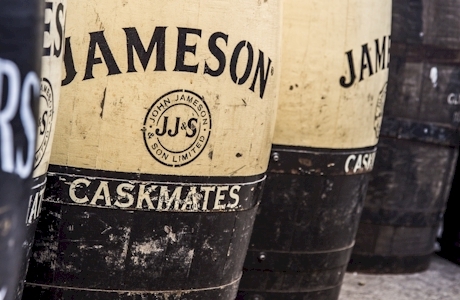IRISH WHISKEY PRODUCTION AND TYPES
Unlike Scotch, Irish whiskeys don’t have regional characteristics or designators. Specific differences in taste and style reflect the source materials, craft, and intentions of each distiller. As interest in Irish whiskey has rebounded, the variety of expressions has exploded. Distillers are experimenting and expanding on their original recipes, fueled by new markets and changing tastes.
MAKING IRISH WHISKEY
THE FOUR MAIN TYPES OF IRISH WHISKEY
Like Scotch, Irish whiskey results from distilling malted or unmalted barley or other grains. The term “single grain” or “single malt” refers to sourcing from one distillery but is often a blend of several whiskeys within its specific type.
- Malt Whiskey
Malt whiskey derives from 100% malted barley distilled solely in pot stills. It can be a blend of malt whiskeys, but if designated “Single Malt,” all of the malt included must be from one distillery. - Pot Still Whiskey
Pot still whiskey requires at least 30% malted barley, 30% unmalted barley, and a maximum of 5% other grain(s), all distilled in pot stills. Again, the whiskey can be a blend, but to use the name “Single Pot Still,” all of the components must be from one distillery.
Grain Whiskey
Grain whiskey has less than 30% malted barley, either from mixed grain distillation or blending with grain whiskey. “Single Grain” designation requires that all components source from one distillery. - Blended Whiskey
As with Scotch, blended Irish whiskey comprises the largest segment of production. Made by combining malt and grain whiskeys from different distilleries, they tend to be consistent in flavor and quality across batches and years. The standard expressions from Jameson, Bushmills, Tullamore, and many others have built a solid reputation based on their blends.
AGES and EXPRESSIONS
To meet the demand for variety, and to compete with the extensive quality variations of Scotch, Irish distilleries offer ever-increasing choices in aging lengths and style expressions.
- AGING/MATURATION
As with all whiskeys, aging impacts flavor, smoothness, quality, and price. Age statements on Irish whiskey bottles must represent the youngest component whiskey, with a legal minimum of three years. Aging impacts smoothness and flavor intensity as the cask and maturation interact with the whiskey. Age also correlates with price. Even twelve-year whiskeys can sell for double or triple similar NAS (non-age statement) whiskeys. - EXPRESSIONS
Irish whiskey matures in oak casks often reused for generations. With the growth of American Bourbon production, Scotch and Irish whiskey producers began purchasing the used bourbon casks for their desired flavor and aroma characteristics. As Scotch producers began experimenting with different casks (sherry, rum, wine, and more), so did Irish whiskey distillers. Today, distillers may use a variety of methods to change the flavor imparted in maturation, including charring the interiors of casks (much like bourbon distillers), and even barrels charred with burning dried seaweed! Additionally, blending different whiskeys and employing multiple casking options can achieve alternative flavors. The only constraint is the imagination of the distiller!

